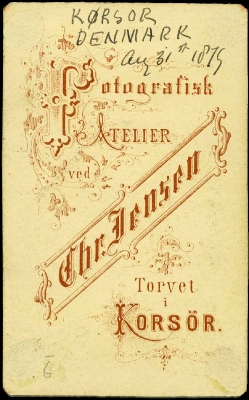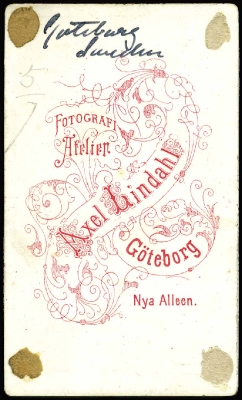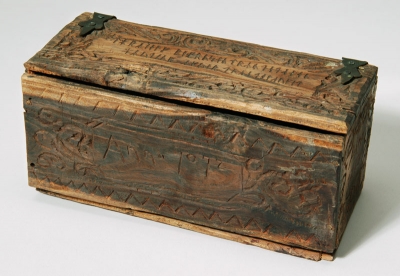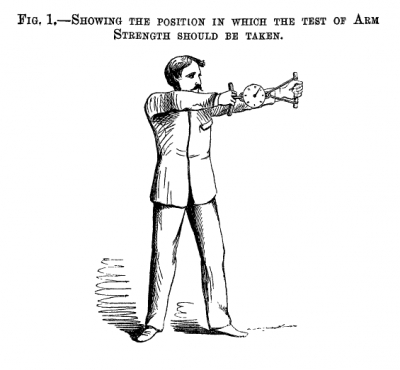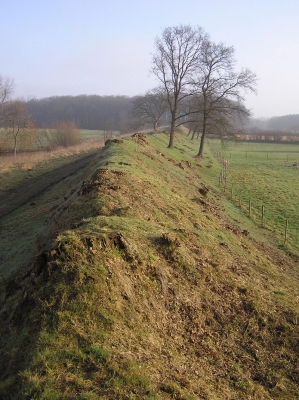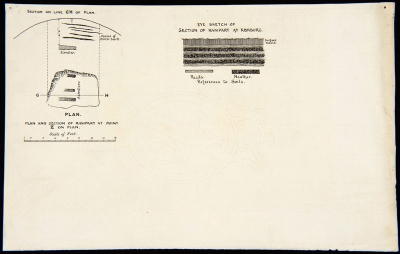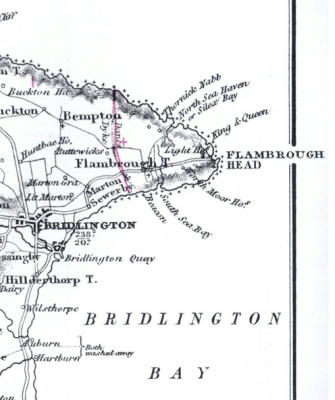Augustus Lane Fox and George Rolleston in Scandinavia, 1879
Christopher Morton
This article relates to two other articles by me on this website, dealing with the Founding collection of photographs at the Pitt Rivers Museum, and the Australian prints that Lane Fox purchased from the Godeffroy Museum.
In August and part of September 1879, Lane Fox (he would not gain the additional name Pitt-Rivers until the following year) and George Rolleston, Linacre Professor of Anatomy and Physiology at the University of Oxford and one of Pitt-Rivers’ few close friends, made a journey together to Scandinavia. This much was known to Pitt-Rivers’ biographers already, but little more. [1] This article is an attempt to sketch some more of the details of this journey, based on available evidence. The journey was a particularly significant one in the development of Pitt-Rivers’ collection as it was displayed at the South Kensington Museum from 1879–84, since it was the main collecting trip for photographs used in the section on physical anthropology, which at South Kensington consisted largely of photographs, as well as skulls and hair samples.
As the following map makes clear, many of the places that Lane Fox and Rolleston visited during their journey can be identified by the photographs and objects that were collected during their travels. Indeed, given that no correspondence or diaries have yet been found relating to the journey, it is only the documentation relating to collections that allow us to sketch their journey. It is possible that further archival evidence will come to light in the course of research, but for now we rely, in terms of a general understanding of the purpose of their visit, on brief references, such as this by EB Tylor in his ‘Life of George Rolleston’ which prefaced the collection of papers in Rolleston’s honour after his early death in 1881:
It was eight years before he made another distant journey, when in 1879 he went with General Pitt-Rivers to Sweden. He was much struck with the manliness of Scandinavian life, the absence of the worst side of poverty, the provisions for public enjoyment, the behaviour of the upper classes contrasting advantageously with England, and the active influence of the Court for good. The object of their visit was to see Museums and Universities, and they were impressed, not indeed with any of these excelling what might be seen at home, so much as by the educational activity among a nation so much less in number and wealth than Great Britain. In a letter written next year to General Pitt-Rivers, Dr Rolleston comments on ‘this cheeseparing Government’. ‘I should be in despair if it were not for what we saw done by people of the same flesh and blood as ourselves, but much poorer and less aristocratic, last summer. Recollect what sums are spent, and, as the enclosed cutting from the Times of yesterday shows, are going on being spent by democratic Scandinavians for Science. [2]
The journey
Lane Fox and Rolleston appear to have sailed first to Hamburg, and there visited the Godeffroy Museum. During this visit Lane Fox purchased around 70 photographs and around 40 “duplicate” objects – that is, objects which duplicated ones already in the Godeffroy Museum collection and were thus put up for sale – which on his return he sent to the Bethnall Green museum (26 September). An early label for one such object for instance – an artificial beard from Papua New Guinea (1884.114.5) – reads ‘Obt. from Godeffroy Museum’.
Probably the next stop was Kiel, where Lane Fox purchased photos from Waldemar Renard of Sophienblatt 18. He also collected a lamp (1884.116.106), described as a ‘well made hanging lamp of thick iron, hinged pan cover with hook and eye and tube wick holder’ and which he sent to the South Kensington Museum on 17 February 1880.
Travelling north, the next stop was probably Schleswig, where Lane Fox purchased photographs from Seligmüller and Neubauer of Stadtweg 147. In the vicinity of Schleswig, Lane Fox and Rolleston conducted a brief test excavation of the ramparts of the prehistoric earthwork known as the Danevirke, which runs across the peninsula at this point. I discuss the significance of this in more detail below.
The next place they are known to have visited was Korsør, in Denmark. Here, Lane Fox purchased photographs from Christian Jensen at Torvet. These cartes-de-visite were annotated “31.8.1879” by Lane Fox in ink on the reverse, suggesting the date that they reached Korsør. A number of flint objects [1884.132.173-176; 1884.132.363-364; 1884.70.27; 1884.132.105] were collected by Lane Fox from the coastal surface at Korsør at this time. Rolleston also collected a flint core and flakes [1935.46.29] which were later transferred to the PRM, documented as from a kitchen midden. It is important to note that Alfred Heneage Cocks (1851–1928) was also in the area at the same time, and that some objects he collected then (1891.56.9), described as ‘from N. shore of Fjord, Korsør’ [1891.56.9] were later purchased by Henry Balfour for the PRM in 1891 from his sale of Scandinavian objects.[3]
The next stopping point is likely to have been Copenhagen. We know that Rolleston was planning to visit the city during this trip since on 30 July 1879, as he was preparing to leave, William Greenwell wrote to him:
Many thanks for your proferred help but I do not think there is anything I want from Copenhagen etc. You must see at Copenhagen Sophus Müller whom perhaps you may know.[4] His father is the head of the coin collection, and he is himself one of the best of the young archaeologists I have met with, is a most pleasant fellow withal.
Whilst in the city, Lane Fox purchased photographs from Budtz Müller & Co, and collected a number of objects, such as an Iron horse-shoe (1884.50.6), a money box in the form of a red and white glazed earthenware bird (1884.68.135), an iron spear-head (1884.120.49) and a flint axe head that he may have acquired at the museum in Copenhagen (1884.125.343).
Two photographs marked as coming from the studio of Otto Pettersson in Lund suggest that this may have been the next stopping place on the journey.
Crossing the border into Sweden, it is likely that the pair next stopped off in Halmstad, since Lane Fox collected four photographs marked as coming from the studio of Selma Angel, in the Fredrickswall area of the town.
Travelling further north along the coast road, Lane Fox purchased photographs from Axel Lindahl of Nya Allén, Göteborg. He also collected a cart horse pad with curved wooden rein-carrier (1884.51.13), a wooden box with a runic inscription on the lid (1884.98.15), three ancient stone chess men (1884.100.13-15), a small copper or brass cattle bell (1884.108.16) and a glass bottle (1884.140.288). EB Tylor noted that Rolleston was particularly impressed with the control of alcohol by the Gothenburg authorities:
Among the various letters written by Dr Rolleston to the Times is one of Sept 18, 1879, where, on his return from a tour in Scandinavia, he gives the result of his examination of the ‘Gothenburg system’, under which the Municipality itself carries on the public-houses. [5]
Moving inland, Lane Fox purchased some thirty-seven photographs from the studio of Herman Stafhell, Jönköping.
Reaching Stockholm, Lane Fox possibly collects one photograph (1998.256.98). That he also visited Artur Hazelius's museum (the Skandinavisk-ethnografiska samlingen) is suggested in a letter he wrote to AW Franks in July the following year, in which he writes that ‘Hazselus’s museum at Stockholm is a good case in point. What he has done is just marvellous. But if he had been fettered by the government he could never have carried it out.’ (PRM Papers, Box 1) During his stay in the city, Lane Fox collected several horse shoes (1884.50.13–16), documented as having been collected in Stockholm in Aug 1879.
The most northerly point of their journey as evidenced in the extant material was Uppsala, where Lane Fox purchased about a dozen photographs from the studio of Sophie Löfström, which was located on Östra Ågatan 17. Whilst it is possible that these cartes-de-visite were not collected in Uppsala itself, or that his acquisition of them is not firm proof of their having visited the place, the way in which the collection of cartes-de-visite and objects matches in other locations suggests that it is likely they did briefly visit the town.
Collecting photographs
In the autumn/winter of 1878 and spring of 1879 Lane Fox journeyed to Brittany (Thompson, 1977: 125), conducting surveys of antiquities and collecting objects. He also made a collection of some 300 cartes-de-visite which he sent to the South Kensington Museum in May 1879.[6] Before this donation Lane Fox had not collected photographs in any systematic or concerted way, and they did not feature in any meaningful didactic sense in his displays at Bethnal Green from 1874. That they did so after 1879 is evidenced in the changing descriptions we have of the physical anthropology section of his collection, which was described in 1874 at Bethnal Green as consisting ‘of a small collection of typical skulls and hair of races’,[7] but in 1879 at South Kensington as ‘a collection of photographs of the various races of mankind which is not as yet far advanced, though it contains large and instructive series of portraits of Danes, Scandinavians, the people of Brittany, and Japanese; whilst together with the photographs is a small series of those skulls which show the best marked racial characteristics, and another which is to exhibit the various modifications in the forms of their skulls which are made by different races.’[8]
As I have discussed in more detail in the article on the Founding collection of photographs, it would appear that the move of Lane Fox’s displays to South Kensington in late 1878 precipitated an expansion in the photographic content of those displays, particularly the physical anthropology section. It is possible that his 1879 Scandinavian journey gave Lane Fox the opportunity to collect more relevant photographic material, but given that much would have already been readily available through his various professional contacts, this explanation is not a satisfactory one. A more plausible explanation would be the influence of George Rolleston upon Lane Fox, a man whose opinion, wrote Pitt-Rivers in a letter in 1880, ‘I attach much value’.[9] Although it is not known when they met, both were members of the same learned societies including the Royal Society, Anthropological Institute and Anthropological Section of the British Association for the Advancement of Science [BAAS], and in 1875 they both served on the Anthropometric Committee of the BAAS.[10] As Rolleston’s influence on Pitt-Rivers grew in the 1870s, it is possible that the latter’s interest in physical anthropology also grew, resulting in the augmentation of this section of the displays after their move to South Kensington.
In 1877 Pitt-Rivers published a paper in which he discusses measuring all the officers and men of the 2nd Royal Surrey Militia in May 1876 ‘according to the instructions drawn up by the Anthropometric Committee of the British Association’.[11] And in the President’s Annual Address the same year he argued that ‘The great variety of opinions upon this subject [i.e. the origins of the Polynesians] … points to the deficiency of reliable data, and to the necessity of imparting, if possible, a fresh impulse to our departments of descriptive ethnology and physical anthropology.’[12] Lane Fox’s growing interest in the use of photography for physical anthropology is made explicit in a note he authored in an 1878 report from the Anthropometric Committee:
The attention of the Committee has also been drawn to the desirability of endeavouring to ascertain by means of photographs the various types of physiognomy prevailing in different districts. That characteristic differences of countenance do exist in different parts of the country appears very probable. But the difficulty of obtaining any reliable statistics on the subject is very great, owing to the almost impossibility of establishing any recognised standard of comparison for features; where one person will fix upon a particular class of physiognomy as characteristic of a district, another person in the same district will select something totally different. It is laid down that the only true method of obtaining reliable results should be by obtaining as large a number of photo- graphs as possible of persons from different localities whose descriptions should be, as far as possible recorded in the manner laid down in the Anthropometric instructions regardless of type; and the Committee should then determine typical forms from an examination of the photographs thus obtained. This, however, entails the collection of an enormous number of photographs, to be followed possibly by some little difference of opinion on the part of the Committee appointed to estimate the type. [13]
That Lane Fox and the Anthropometric Committee favoured obtaining large numbers of photographs of people for comparison goes some way to explaining his collection of around 650 cartes-de-visite of random individuals in Brittany and Scandinavia, as well as the didactic rationale for presenting them in his displays. By showing numerous examples of commercially-produced cartes-de-visite it seems clear that Lane Fox was intending to demonstrate certain correspondences between individuals from localities, such as Brittany, although unfortunately no text accompanying these displays survives.
The choice of images showing Scandinavian individuals may also have had further research significance. In his section of the 1877 book British Barrows, Rolleston noted that ‘The tall powerfully-made brachy-cephalous Briton of the round-barrow period all but certainly presented much the same combination of physical peculiarities as the modern Finn and Dane’. [14] Given both Lane Fox and Rolleston’s interest at that time in questions of the dating and origin of certain British archaeological features, such as Dane’s Dyke, a study collection of photographs of contemporary Scandinavian individuals may have afforded comparison with Rolleston’s measurements of Bronze Age ‘round headed’ (brachy-cephalic) skulls. Such comparative data may well have been considered by both men as useful in the debate over the origins of the brachy-cephalic people, since, as Rolleston noted, ‘the likeness between these and some of the modern Danes has been noticed by Virchow… There are not wanting … reasons for supposing that the brachy-cephalic people of the round-barrow period may have immigrated into this country from the Cimbric Peninsula.’ [15] Whilst evidence for this is lacking, it is worth noting that some of the other physical anthropological material displayed in this section (as evidenced in the 1874 catalogue of the displays) may have been explicitly brought into comparison with the photographs, in particular a series of casts of heads from Lappland and Sweden, as well as skulls of various dates from Britain, including a ‘skull found in a grave in Highdown Hill with a bronze socket dagger’, which may have been compared to the modern Scandinavian individuals shown in the photographs. [16]
Investigating the Danevirke
The Danevirke is a linear ditch and bank earthwork that runs from coast to coast across the Cimbrian Peninsula in Schleswig-Holstein, in modern-day northern Germany. When visiting the town of Schleswig, Lane Fox and Rolleston carried out a limited test excavation of the earthwork at a place called Korborg, four miles east of Schleswig.
The only written comments made by Pitt-Rivers or Rolleston about their investigation of the Danevirke come in the 1881 publication Excavations at Mount Caburn Camp, and in passing in his 1892 account of his excavations of Wansdyke (1892: 254). In the former, Pitt-Rivers writes that:
(Since this paper was read I have had an opportunity, in conjunction with Professor Rolleston, of examining the great Danewirke, which runs across Jutland from Schleswig. This fortification has been renewed and altered at different periods, and there is evidence of successive additions, but the oldest portions of it may even date as far back as prehistoric times. Borrowing a spade from a neighbouring cottage we dug into this rampart at a place where a natural breach had already been partly made, and found, at a depth of about 6 feet from the top, a layer of horizontal beams running across the rampart; they consisted of stems of beech trees, about 6 inches in diameter, with the bark on, and at irregular intervals of 2 to 4 feet apart beneath this, at about 9 inches between, was another layer of beams in the same direction, and horizontally across the beams were layers of birch bark intended to serve as bonding. We found the same construction in several places on the line of the rampart.)
Although Pitt-Rivers notes here that their investigation of the earthwork had revealed several phases over a considerable period, nowhere does he elaborate on these findings. It is likely however that their investigation was closely linked with the disputed dating of Dane’s Dyke on Flamborough Head, which Lane Fox excavated on his return from Scandinavia in October 1879.
We now know that Lane Fox also surveyed the Danevirke in some detail, since two pages of sketch plans (below) have recently been discovered that show the location of the test section dug by them, as well as a survey of the ditch and bank extending over more than 6000 feet. The plans were donated by Lane Fox’s great-grandson Anthony Pitt-Rivers in 2012, along with other plans, watercolours and photographs connected with Pitt-Rivers’ work as Inspector of Ancient Monuments.
In his 1877 publication British Barrows, the archaeologist William Greenwell had argued regarding Dane’s Dyke that:
His [Lane Fox’s] opinion is that these earthworks and their arrangement for defensive purposes are only to be explained on the supposition that they were made by a body of men advancing from the East, and gradually entrenching themselves as they extended their progress towards the West … It is scarcely to be looked for that an invading people would practise any new mode of entrenchment upon their first arrival, and therefore we would expect to find in the country from which they came some arrangements for defence similar to those in question. But in that part of Europe from which it is known the Angles and other nearly-connected tribes emigrated into this country, very few works at all resembling those in question are to be found. It is true that the great line of the Dannewerk runs across from sea to sea … but if in later times it was ever anything more than a divisional or boundary work, it seems probably it represents a line of defence constructed at a time antecedent to the Scandinavian occupation of Denmark. [17]
Pitt-Rivers comment in 1881 that the Danevirke had been ‘renewed and altered at different periods’ suggests that both men considered at the time that their limited excavation had demonstrated that the earthwork had been used defensively in more recent historic times, and that this may well counter Greenwell’s assertion that the similar earthwork on Flamborough Head had no European precedent in the historic period. Lane Fox evidently wrote to Greenwell immediately on their return in September 1879 to tell him of his findings, since Greenwell relays this in a letter soon afterwards to Rolleston, on 6 October 1879:
You and Fox seem to have settled some stiffish points in Scandinavia, so at least I gather from a letter in which he tells me that his opinion is that the wold entrenchments were thrown up by the Anglian invaders. To this I entirely dissent, for reasons stated in British Barrows; that book will be the ruin of us both… [18]
Less than two weeks after Greenwell had written this letter to Rolleston, Pitt-Rivers began his excavations at Dane’s Dyke, cutting a section through the earthwork. Finding that flint artefacts predominated, Pitt-Rivers concluded that ‘the work itself is not later than the bronze period; it is, in fact, of the same age as the tumuli of the Yorkshire Wolds.' But as to who had constructed the earthwork, Pitt-Rivers now sought to rule out more recent ‘Anglian invaders’ (i.e. Denmark) as their origin, arguing that the people of the wold burials were established as belonging to the early Bronze Age, whereas ‘the early bronze age did not exist in Denmark’.[19] Instead, he argued, the builders of Dane’s Dyke were likely to be those same people found elsewhere in southern Britain, or else people driven to the coast by another invader ‘and that the defences we are considering were associated with the last occupation of the soil of Yorkshire’. [20]
In many ways this volte-face on the part of Pitt-Rivers on the question of the antiquity of Dane’s Dyke was a vindication of Greenwell’s opinion as expressed in British Barrows. But the more important point for archaeology is that it shows Pitt-Rivers’ willingness to modify, even completely change, a strongly held conjectural position in favour of the evidence of excavation. And indeed, given that the limited evidence that he and Rolleston uncovered at the Danevirke did point to more recent use of such earthworks, it was only natural that this opinion be tested. In fact it would appear that Rolleston and Lane Fox were the first to find firm evidence, in their description of horizontally laid logs, for the substantial later renewal of the Danevirke. In his recent article on the earthwork, Andres Siegfried Dobat writes that: ‘In 737, the appearance of Danevirke radically changed once again when the structure became a linear fortification of previously unknown scale (Danevirke IV)… In the Main Wall, the resumption of building activity involved a heightening of the rampart by several metres and, as a new building technique, a massive wooden facing of the southern front … With its internal box-frame construction of logs laid horizontally and interlocked on the ends with notches, it resembles the architectonic features of the Main Wall at Lake Danevirke. Functionally, it apparently worked with one or several linear earthworks on the southern tip of the Reesholm peninsula to prevent the crossing of a natural ford across the Schlei Fjord. Phase IV represents an extraordinary enterprise and a hitherto unparalleled investment of material and human resources, at least in a S. Scandinavian context.’ [21]
Christopher Morton
Curator of Photograph and Manuscript Collections
August 2011
Bibliography
Anon., 1874. On the Principles of Classification adopted in the Arrangement of his Anthropological Collection, now exhibited at the Bethnal Green Museum.
Anon., 1880. General Pitt Rivers’ (Lane Fox) anthropological collection, Nature, Sept 23, 489–93; Sept 30, 511–14.
Bowden, M., 1991. Pitt Rivers: The Life and Archaeological Work of Lieutenant-General Augustus Henry Lane Fox Pitt Rivers. Cambridge: Cambridge University Press.
Cocks A. H. 1891. Catalogue of the Scandinavian Exhibition of Antiquities and Other Objects Collected by Alfred Heneage Cocks, on view at the Royal Archaeological Institute, June 1891, 2nd ed. London.
Dobat,A. S., 2008. ‘Danevirke Revisited: An Investigation into Military and Socio-political Organisation in South Scandinavia (c ad 700 to 1100)’, Medieval Archaeology, 52, 27–67.
Fox, A.H. Lane 1877a. ‘Measurements Taken of the Officers and Men of the 2nd Royal Surrey Militia According to the General Instructions Drawn Up by the Anthropometric Committee of the British Association’, Journal of the Anthropological Institute of Great Britain and Ireland, Vol. 6, 443–57.
Fox, A.H. Lane 1877b. President’s Address, Journal of the Anthropological Institute of Great Britain and Ireland, Vol. 6 (1877), 491–510.
Fox, A.H. Lane 1878. Anthropometric Committee, Journal of the Anthropological Institute of Great Britain and Ireland, Vol. 7, 391–393.
Greenwell, Rev. W. and G. Rolleston, 1877. British Barrows. Oxford: Clarendon Press.
Pitt-Rivers, A.H.L.F., 1882. ‘On Excavations in the Earthwork Called Dane's Dyke at Flamborough in October, 1879; and on the Earthworks of the Yorkshire Wolds’, Journal of the Anthropological Institute of Great Britain and Ireland, Vol. 11, 455–71.
Pitt-Rivers, A.H.L.F. 1892. Excavations in Bokerley Dyke and Wansdyke, Dorset and Wilts, 1888–91. Volume III of Excavation in Cranborne Chase. Privately printed.
Thompson, M., 1977. 1977. General Pitt Rivers: Evolution and Archaeology in the Nineteenth Century Bradford-on-Avon: Moonraker Press.
Tylor, E.B., 1884. ‘Life of George Rolleston’, in Scientific Papers and Addresses by George Rolleston, edited by W. Turner. Oxford: Clarendon Press.
Notes
[1] Bowden 1991: 87, Thompson 1977: 57, 125
[2] Tylor 1884: lxi
[3] See Cocks A. H. 1891.Cocks was also Henry Balfour's traveling companion on a trip to Scandinavia in 1888 (See Balfour Papers, Box 1, Finmarken and Lappland diary, 1888).
[4] Sophus Otto Müller (1846–1934), Danish archaeologist
[5] Tylor 1884: lv
[6] PRM ‘Green Book’ – receipts from South Kensington Museum sent to Pitt-Rivers.
[7] Anon. 1874
[8] Anon. 1880: 490
[9] Salisbury and South Wiltshire Museum, Pitt-Rivers Papers, P125.
[10] Alison Petch, 2011 Rethinking Pitt-Rivers | Pitt-Rivers and Rolleston
[11] Lane Fox 1877a: 112
[12] Lane Fox 1877b: 504
[13] Lane Fox 1878: 393
[14] Greenwell and Rolleston 1877: 680
[15] Loc. cit.
[16] Alison Petch, 2011 Source: Rethinking Pitt-Rivers | Human skull series
[17] Greenwell 1877: 123–4
[18] Rolleston Papers, Ashmolean Museum. Letter from W. Greenwell to G. Rolleston, 6 October 1879.
[19] Pitt-Rivers 1882: 467
[20] Ibid., 468)
[21] Dobat 2008: 40

